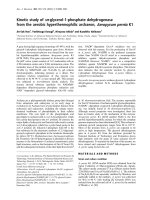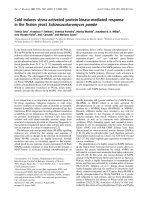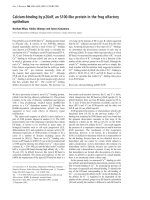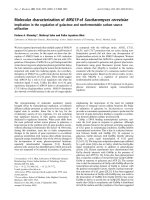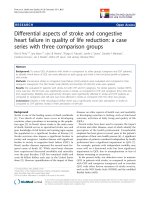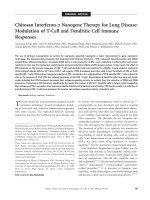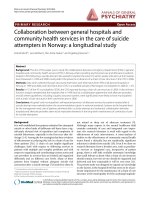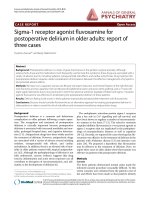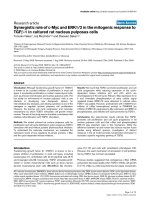Báo cáo y học: "Prolonged high-dose intravenous magnesium therapy for severe tetanus in the intensive care unit: a case series" pot
Bạn đang xem bản rút gọn của tài liệu. Xem và tải ngay bản đầy đủ của tài liệu tại đây (423.73 KB, 5 trang )
JOURNAL OF MEDICAL
CASE REPORTS
Karanikolas et al. Journal of Medical Case Reports 2010, 4:100
/>Open Access
CASE REPORT
BioMed Central
© 2010 Karanikolas et al; licensee BioMed Central Ltd. This is an Open Access article distributed under the terms of the Creative Com-
mons Attribution License ( which permits unrestricted use, distribution, and reproduc-
tion in any medium, provided the original work is properly cited.
Case report
Prolonged high-dose intravenous magnesium
therapy for severe tetanus in the intensive care
unit: a case series
Menelaos Karanikolas*
1
, Dimitrios Velissaris
1
, Markos Marangos
2
, Vassilios Karamouzos
1
, Fotini Fligou
1
and
Kriton S Filos
1
Abstract
Introduction: Tetanus rarely occurs in developed countries, but it can result in fatal complications including
respiratory failure due to generalized muscle spasms. Magnesium infusion has been used to treat spasticity in tetanus,
and its effectiveness is supported by several case reports and a recent randomized controlled trial.
Case presentations: Three Caucasian Greek men aged 30, 50 and 77 years old were diagnosed with tetanus and
admitted to a general 12-bed intensive care unit in 2006 and 2007 for respiratory failure due to generalized spasticity.
Intensive care unit treatment included antibiotics, hydration, enteral nutrition, early tracheostomy and mechanical
ventilation. Intravenous magnesium therapy controlled spasticity without the need for additional muscle relaxants.
Their medications were continued for up to 26 days, and adjusted as needed to control spasticity. Plasma magnesium
levels, which were measured twice a day, remained in the 3 to 4.5 mmol/L range. We did not observe hemodynamic
instability, arrhythmias or other complications related to magnesium therapy in these patients. All patients improved,
came off mechanical ventilation, and were discharged from the intensive care unit in a stable condition.
Conclusion: In comparison with previous reports, our case series contributes the following meaningful additional
information: intravenous magnesium therapy was used on patients already requiring mechanical ventilation and
remained effective for up to 26 days (significantly longer than in previous reports) without significant toxicity in two
patients. The overall outcome was good in all our patients. However, the optimal dose, optimal duration and maximum
safe duration of intravenous magnesium therapy are unknown. Therefore, until more data on the safety and efficacy of
magnesium therapy are available, its use should be limited to carefully selected tetanus cases.
Introduction
Tetanus is a rare and potentially fatal disease caused by
tetanospasmin, a Clostridium tetani exotoxin. Patients
with tetanus manifest generalized muscle rigidity that can
cause respiratory failure, thus requiring both admission
to an intensive care unit (ICU) and mechanical ventila-
tion. Case reports, uncontrolled case series and a recent
randomized controlled trial (RCT) from Vietnam suggest
that magnesium (Mg) is an interesting treatment option
for tetanus, but concerns regarding Mg therapy risks still
exist. We present three patients with tetanus who were
admitted to the ICU at Patras University Hospital for
respiratory failure. They received prolonged high-dose
intravenous Mg therapy and had good outcomes.
Case presentation
All three patients we describe in this case series were
admitted to our hospital's ICU for generalized muscle
rigidity and respiratory failure requiring intubation and
mechanical ventilation. During their ICU stay all of them
received central (subclavian or internal jugular vein) and
radial arterial lines. All of them received propofol com-
bined with clonidine for sedation. According to ICU pro-
tocol, their hypotension (defined as mean arterial
pressure [MAP] <50 mmHg) was treated with continuous
intravenous norepinephrine infusion. Our patients' bra-
dycardia, which is defined as having a heart rate of <45/
* Correspondence:
1
Department of Anaesthesiology and Critical Care Medicine, Patras University
Hospital, Rion, 26500, Greece
Full list of author information is available at the end of the article
Karanikolas et al. Journal of Medical Case Reports 2010, 4:100
/>Page 2 of 5
minute, was treated with intravenous atropine and/or
continuous isoproterenol infusion. Meanwhile, their
tachycardia, which is defined as having a heart rate of
>110/min, was treated with continuous esmolol infusion.
All our patients received low molecular weight heparin
for deep venous thrombosis prophylaxis and enteral
nutrition through an orogastric tube. Their urine output
was maintained above 0.5 mL/kg/hour by using appropri-
ate intravenous fluid administration.
The effectiveness of Mg therapy was evaluated with
daily wake-up tests in order to assess muscle rigidity and
the ability of our patients to breathe spontaneously with
pressure support while awake. When the wake-up test
indicated insufficient rigidity control, their Mg dose was
increased by 10% to 15%. On the other hand, when no
rigidity was noted the dose was reduced by 10% to 25%.
Data collection was retrospective.
Case report 1
A 50-year-old Caucasian Greek man with a history of
excess alcohol use, hepatitis C virus (HCV) infection and
intravenous drug use was admitted to the ICU for gener-
alized spasms, opisthotonus and severe respiratory dis-
tress. He had received a tetanus vaccination in childhood
and a booster tetanus vaccine during military service in
his 20s, but had not received any tetanus vaccination in
20 years. Upon arrival at the ICU he required intubation
and positive pressure ventilation. Initial antibiotic ther-
apy consisted of meropenem, vancomycin and metron-
idazole. Colistin and gentamicin were added seven days
later for Enterobacter cloacae pneumonia with positive
blood cultures.
Because of hypotension, he received continuous
intavenous norepinephrine infusion for five days during
an episode of sepsis. Because his condition was critical,
and in our judgment he was unlikely to come off the ven-
tilator quickly, an elective percutaneous tracheostomy
was performed on his third day in the ICU. His muscle
rigidity improved within a few hours after we started him
on Mg infusion. However, as his muscle rigidity on daily
wake-up tests persisted, his intravenous Mg infusion con-
tinued for 26 days, with a total Mg dose of 337 g. His
plasma Mg levels were measured daily and remained in
the 3 to 4 mmol/L range. Our patient gradually improved,
was weaned off the ventilator, and was discharged from
the ICU in a stable condition after 30 days.
Case report 2
A 77-year-old Caucasian Greek man without any signifi-
cant medical history was admitted to the ICU for respira-
tory failure due to generalized spasticity. A week earlier
he had had a right foot injury that had resulted in a small,
tender, erythematous, palpable mass. He did not have any
written immunization records, but he was certain that he
had not received any tetanus vaccine in over 20 years.
Upon his arrival at the ICU he was sedated, intubated
and supported with positive pressure ventilation. His
muscle rigidity was initially treated with analgesia, seda-
tion and intermittent intravenous cisatracurium boluses.
His antibiotic therapy included ceftriaxone and metron-
idazole. We performed a percutaneous tracheostomy on
our patient on his seventh day in the ICU. As his muscle
rigidity persisted, we initiated him on continuous intrave-
nous Mg infusion on day 8 in an attempt to reduce his
need for non-depolarizing muscle relaxants. His rigidity
improved significantly after he was started on Mg infu-
sion, and within a few hours he no longer required non-
depolarizing muscle relaxants. His plasma Mg levels were
measured daily. His spasticity was well-controlled, with
his Mg plasma levels maintained within the 4 to 4.5
mmol/L range. Our patient came off the ventilator on day
14 and his Mg infusion was stopped on day 16. He was
discharged from the ICU in a stable condition on day 22.
Case report 3
A 30-year-old Caucasian Greek man was admitted to the
ICU with a diagnosis of tetanus manifesting as general-
ized spasms, trismus and dysphagia. He had apparently
self-administered heroin with a contaminated needle
three days before he became ill. He had received a tetanus
vaccination during childhood, but had not had a booster
tetanus vaccine for at least 10 years. On ICU admission
his hemodynamic variables were stable. He was started
immediately on intravenous Mg therapy and his rigidity
clearly improved after 3 to 4 hours. Because of persistent
rigidity in his daily wake-up tests, however, his Mg ther-
apy continued for 26 days. His antibiotic therapy included
meropenem, vancomycin and metronidazole. His airway
was secured with percutaneous tracheostomy on day 5.
After a prolonged ICU stay without major complications,
his intravenous Mg therapy was discontinued on day 26.
He was weaned off the ventilator on day 28 and was dis-
charged from the ICU in a stable condition on day 32.
Demographic, therapy and outcome data are presented
in Table 1. Autonomic nervous system instability was not
a problem, as all patients (except for patient 1 during a 5-
day episode of sepsis) maintained cardiovascular stability.
Intravenous Mg therapy resulted in excellent muscle
spasm control for our patients within hours, without the
use of any additional muscle relaxants. However, due to
the persistence of painful muscle rigidity during their
daily wake-up tests, intravenous Mg therapy needed to be
continued for a long period (26 days) in patients 1 and 3.
Our patients tolerated intravenous Mg therapy well with-
out any significant adverse effects, and they were dis-
charged from the ICU in a stable condition.
Karanikolas et al. Journal of Medical Case Reports 2010, 4:100
/>Page 3 of 5
Discussion
Tetanus is a disease of the nervous system and can pres-
ent in one of four forms: generalized, localized, cephalic
and neonatal [1]. In adults, the generalized form, mani-
festing as skeletal muscle rigidity and convulsive muscle
spasms, is the most severe. Urbanization, agriculture
mechanization and socioeconomic factors, including
poverty, poor hygiene and lack of health services, signifi-
cantly influence tetanus incidence. Although the number
of tetanus cases has been declining every year in the last
two decades due to improved vaccination practices, there
are still up to 500,000 cases of tetanus recorded yearly
worldwide.
Tetanus mortality is as high as 45% [2-4]. A total of 75%
of deaths occur within the first week, primarily from pul-
monary infection, aspiration or pulmonary embolism. Up
to 163,000 deaths were attributed to tetanus in 2004 [5].
Tetanus incidence is markedly low in developed coun-
tries. Between 1972 and 2001, only 1842 tetanus cases
were reported in the United States [3]. The annual inci-
dence per million decreased from 0.39 in 1972 to 1976 to
0.16 in 1997 to 2001, while case fatality rate (CFR)
decreased from 45% to 16% [3]. Among the reported 932
patients recorded, 644 (69%) were unvaccinated. Mean-
while, CFR was recorded at 28%. Tetanus incidence and
mortality are highest in those aged over 60 (with an inci-
dence of 0.78 per million, CFR 40%). Diabetes is strongly
associated with the risk of fatal tetanus (age-adjusted rel-
ative risk = 1.9; 95% confidence interval [CI] at 1.4 to 2.6).
Approximately 50% of tetanus cases in the USA occur
after injuries [1], but intravenous drug use is becoming
increasingly significant. Injection drug users accounted
for 12% of tetanus cases in 1992 to 2001, a three-fold
increase compared with the previous decade [3].
After Clostridium tetani spores enter human tissues,
they convert to vegetative forms, multiply (often without
signs of local inflammation or infection), and release tet-
anospasmin [1]. Premonitory symptoms are non-specific
and include restlessness, irritability, headache, jaw pain
and stiffness, back or abdominal pain, and difficulty in
swallowing. Trismus (lock jaw) is the most common
symptom, but tachycardia, low-grade fever and profuse
sweating are also common. Patients with tetanus are
almost invariably conscious and alert when they seek
medical attention. As there are no laboratory findings
specific to tetanus [6], diagnosis is based on history and
clinical symptoms. As more muscles become involved,
generalized rigidity can result in respiratory complica-
tions, including hypoxia and atelectasis. Other complica-
tions include deep venous thrombosis, pulmonary
embolism and cardiovascular instability (hypertension,
tachycardia, arrhythmias and severe vasoconstriction).
The treatment for tetanus usually requires hospitaliza-
tion, placement in a quiet room and observation for
developing complications. Care of patients with tetanus
should include monitoring of vital signs, aspiration of
nasopharyngeal secretions, maintenance of fluid and
electrolyte balance, and treatment of rigidity. Early tra-
cheostomy should be considered because it protects
against suffocation from laryngospasm, reduces aspira-
tion risk, and facilitates mechanical ventilation [7-9].
Table 1: Demography, treatment and outcome data
Case Age/
Gender
PMH Hemodynamic
instability
Inotropic
agents
Total Mg
dose (g)
Mg
therapy
(days)
Additional
sedatives/
Relaxants
Ventilation
(days)
ICU
stay
(days)
Outcome
1 50/M Alcohol, IV
drugs,
Tobacco,
HCV
HR >110/min,
MAP <50
mmHg on ICU
admission
NE 5 days 337 26 Propofol 200-
400 mg/hour
Clonidine
2100 μg/day
22 30 Good
2 77/M HTN,
Tobacco
None None 277 7 Propofol 200-
300 mg/hour
Cisatracurium
PRN, Fentanyl
PRN for 1
week, until Mg
started
14 22 Good
3 30/M IV drugs,
Tobacco,
HCV
None None 758 26 Propofol 300-
500 mg/hour
Clonidine
3000 μg/day
28 32 Good
HCV: hepatitis c virus; HR: heart rate; HTN: hypertension; ICU: intensive care unit; IV: intravenous; M: male; Mg: magnesium; MAP: mean arterial
pressure; NE: norepinephrine, PMH: past medical history; PRN: Pro re nata (As Needed).
Karanikolas et al. Journal of Medical Case Reports 2010, 4:100
/>Page 4 of 5
The main pathophysiological disturbances in tetanus
are caused by tetanospasmin, a neurotoxin produced by
Clostridium tetani. Tetanospasmin enters the nervous
system at the neuromuscular junction, migrates towards
the central nervous system by retrograde axonal trans-
port, and is also carried by lymphocytes. Tetanospasmin
binds at the presynaptic nerve ending of the neuronal
membrane and blocks inhibitory amino acid (gamma
aminobutyric acid [GABA] and glycine) release. Conse-
quently, the absence of inhibitory GABA and glycine
impulses results in spasms, seizures and sympathetic
overactivity [1].
Magnesium is a presynaptic neuromuscular blocker
with vasodilator, catecholamine release blocking and
anticonvulsant properties, all of which are desirable for
spasticity and autonomic dysfunction control in tetanus.
The therapeutic use of Mg in tetanus may cause tempo-
rary muscle weakness or paralysis. It may also lead to
reduced sympathetic activity resulting in vasodilation,
blood pressure reduction and lowering of heart rate [10].
Although all these effects of Mg therapy are desirable,
problems from excessive weakness and hypotension have
been described [11].
Clinical data, including case reports [10] and uncon-
trolled case series [12,13], suggest that Mg therapy is
effective in managing tetanus. A prospective observa-
tional study from Sri Lanka [11] and a recent large RCT
from Vietnam [14] also support the safety and efficacy of
Mg therapy in cases of severe tetanus. Mg reduces the
need for medications to control muscle rigidity and car-
diovascular instability [10,13,14] but does not reduce
mortality and the need for mechanical ventilation [14].
However, as Mg therapy can result in serious adverse
effects, including muscle weakness, paralysis and
hypotension, additional data are needed before Mg is
accepted as the first-line therapy for tetanus [15-17].
In our report we describe three patients with tetanus
and respiratory failure who required prolonged mechani-
cal ventilation and ICU care. All three patients received
prolonged continuous high-dose intravenous Mg therapy,
had early percutaneous tracheostomy, and were success-
fully weaned off mechanical ventilation when their spas-
ticity improved. Except for a single sepsis episode in one
of our patients, they did not exhibit hemodynamic insta-
bility during treatment. All our patients left the ICU in a
stable condition, and did not need further treatment for
spasticity.
Most reports on intravenous Mg therapy for tetanus
come from developing countries such as Sri Lanka [11]
and Vietnam [14]. In most published cases, intravenous
Mg therapy was used in an attempt to avoid mechanical
ventilation in the context of scarce ICU resources. Our
case series may be the only report on the use of intrave-
nous Mg therapy in the European Union, where tetanus is
rare. In an attempt to describe the use of intravenous Mg
in patients with tetanus already requiring mechanical
ventilation, our report may have included sicker patients
than those described in other publications. Our reason
for using Mg therapy was to avoid the use of non-depo-
larizing muscle relaxants and not to avoid mechanical
ventilation. In addition, two of the three patients we
described in this report received intravenous Mg therapy
for a very long period (26 days), which is significantly lon-
ger than described in previous reports.
The observation that high-dose intravenous Mg ther-
apy, if carefully titrated and monitored, can continue for a
long time without obvious adverse effects or major organ
toxicity is, in our opinion, the most interesting finding in
our report. Therefore, we believe that this report is a
meaningful addition to the literature on Mg therapy for
tetanus-related spasticity in patients requiring prolonged
mechanical ventilation in the ICU.
Our experience suggests that prolonged high-dose
intravenous Mg infusion therapy is effective in managing
tetanus and can be implemented without major toxicity.
However, Mg therapy can be associated with serious
adverse effects, and our data are insufficient to confirm
the safety of this therapy. Until more data from RCTs are
available, we believe that high-dose intravenous Mg ther-
apy is a promising treatment option. It should, however,
be reserved for selected patients who have intractable
spasticity despite adequate sedation and analgesia and
who may otherwise require prolonged therapy with non-
depolarizing muscle relaxants.
Conclusion
As tetanus is becoming rare due to widespread vaccina-
tion, experience in treating severe tetanus in developed
countries is limited. The effectiveness of intravenous Mg
therapy for spasticity in tetanus is supported by case
reports, uncontrolled trials and a recent RCT. We present
three patients with severe tetanus complicated by respira-
tory failure and who, as such, require mechanical ventila-
tion. All three patients required ICU treatment and
prolonged intravenous Mg infusion at unusually high
doses. Mg toxicity never became a problem, and all three
patients improved and were discharged from the ICU in a
stable condition. This report provides additional evidence
supporting the use of Mg therapy in severe tetanus. How-
ever, as Mg therapy can have significant adverse effects,
additional data from large RCTs that confirm its efficacy
and safety are needed before Mg therapy can be accepted
as the first-line therapy for tetanus.
Consent
Written informed consent was obtained from our
patients for publication of this case series and any accom-
Karanikolas et al. Journal of Medical Case Reports 2010, 4:100
/>Page 5 of 5
panying images. A copy of the written consent is available
for review by the Editor-in-Chief of this journal.
Abbreviations
CFR: case fatality rate; CNS: central nervous system; DVT: deep venous throm-
bosis; HCV: hepatitis C virus; ICU: intensive care unit; IV: intravenous; NE: norepi-
nephrine; RCT: randomized controlled trial.
Competing interests
The authors declare that they have no competing interests.
Authors' contributions
MK introduced Mg therapy for tetanus in the ICU and wrote the manuscript.
DV provided patient care, collected data, and edited the manuscript. MM par-
ticipated in patient care, directed antibiotic therapy, and edited the manu-
script. VK collected data and helped with manuscript editing and submission.
FF provided patient care, collected data and edited the manuscript. KF
directed patient care and edited the manuscript. All authors read and
approved the final manuscript.
Acknowledgements
We want to thank the nursing and ancillary staff of the intensive care unit at
the Patras University Hospital for their remarkable effort in providing excellent
patient care and in facilitating our academic activities in a very difficult environ-
ment.
Author Details
1
Department of Anaesthesiology and Critical Care Medicine, Patras University
Hospital, Rion, 26500, Greece and
2
Department of Internal Medicine, Patras
University Hospital, Rion, 26500, Greece
References
1. Brook I: Current concepts in the management of Clostridium tetani
infection. Expert Rev Anti Infect Ther 2008, 6:327-336.
2. Kefer MP: Tetanus. Am J Emerg Med 1992, 10:445-448.
3. Trends in Tetanus Epidemiology in the United States, 1972-2001
[ />4. Sanford JP: Tetanus: forgotten but not gone. N Engl J Med 1995,
332:812-813.
5. WHO: Immunization surveillance, assessment and monitoring. [http://
www.who.int/immunization_monitoring/diseases/tetanus/en/
index.html].
6. Bleck TP: Tetanus: pathophysiology, management, and prophylaxis. Dis
Mon 1991, 37:545-603.
7. Edmondson RS, Flowers MW: Intensive care in tetanus: management,
complications, and mortality in 100 cases. Br Med J 1979, 1:1401-1404.
8. Rothstein RJ, Baker FJ: Tetanus: prevention and treatment. JAMA 1978,
240:675-676.
9. Sun KO, Chan YW, Cheung RT, So PC, Yu YL, Li PC: Management of
tetanus: a review of 18 cases. J R Soc Med 1994, 87:135-137.
10. Lipman J, James MF, Erskine J, Plit ML, Eidelman J, Esser JD: Autonomic
dysfunction in severe tetanus: magnesium sulfate as an adjunct to
deep sedation. Crit Care Med 1987, 15:987-988.
11. Attygalle D, Rodrigo N: Magnesium as first line therapy in the
management of tetanus: a prospective study of 40 patients.
Anaesthesia 2002, 57:811-817.
12. Attygalle D, Rodrigo N: Magnesium sulphate for control of spasms in
severe tetanus: can we avoid sedation and artificial ventilation?
Anaesthesia 1997, 52:956-962.
13. James MF, Manson ED: The use of magnesium sulphate infusions in the
management of very severe tetanus. Intensive Care Med 1985, 11:5-12.
14. Thwaites CL, Yen LM, Loan HT, Thuy TT, Thwaites GE, Stepniewska K, Soni
N, White NJ, Farrar JJ: Magnesium sulphate for treatment of severe
tetanus: a randomised controlled trial. Lancet 2006, 368:1436-1443.
15. Sutton DN, Tremlett MR, Woodcock TE, Nielsen MS: Management of
autonomic dysfunction in severe tetanus: the use of magnesium
sulphate and clonidine. Intensive Care Med 1990, 16:75-80.
16. Thwaites CL, Farrar JJ: Magnesium sulphate as a first-line therapy in the
management of tetanus. Anaesthesia 2003, 58:286.
17. Williams S: Use of magnesium to treat tetanus. Br J Anaesth 2002,
88:152-153.
doi: 10.1186/1752-1947-4-100
Cite this article as: Karanikolas et al., Prolonged high-dose intravenous mag-
nesium therapy for severe tetanus in the intensive care unit: a case series
Journal of Medical Case Reports 2010, 4:100
Received: 4 November 2009 Accepted: 31 March 2010
Published: 31 March 2010
This article is available from: 2010 Karanikolas et al; licensee BioMed Central Ltd. This is an Open Access article distributed under the terms of the Creative Commons Attribution License ( ), which permits unrestricted use, distribution, and reproduction in any medium, provided the original work is properly cited.Journal of Medical Case Reports 2010, 4:100
